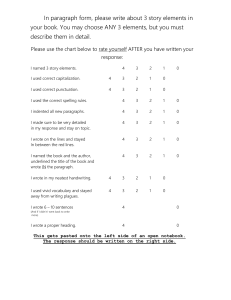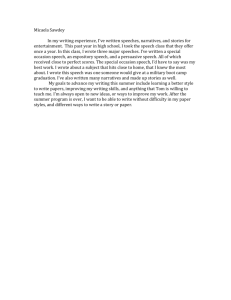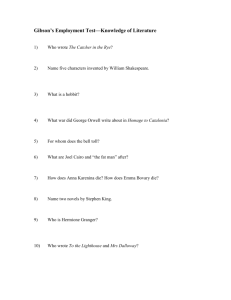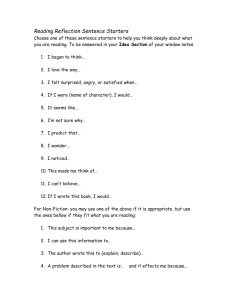People_in_Planning - American Planning Association Colorado
advertisement
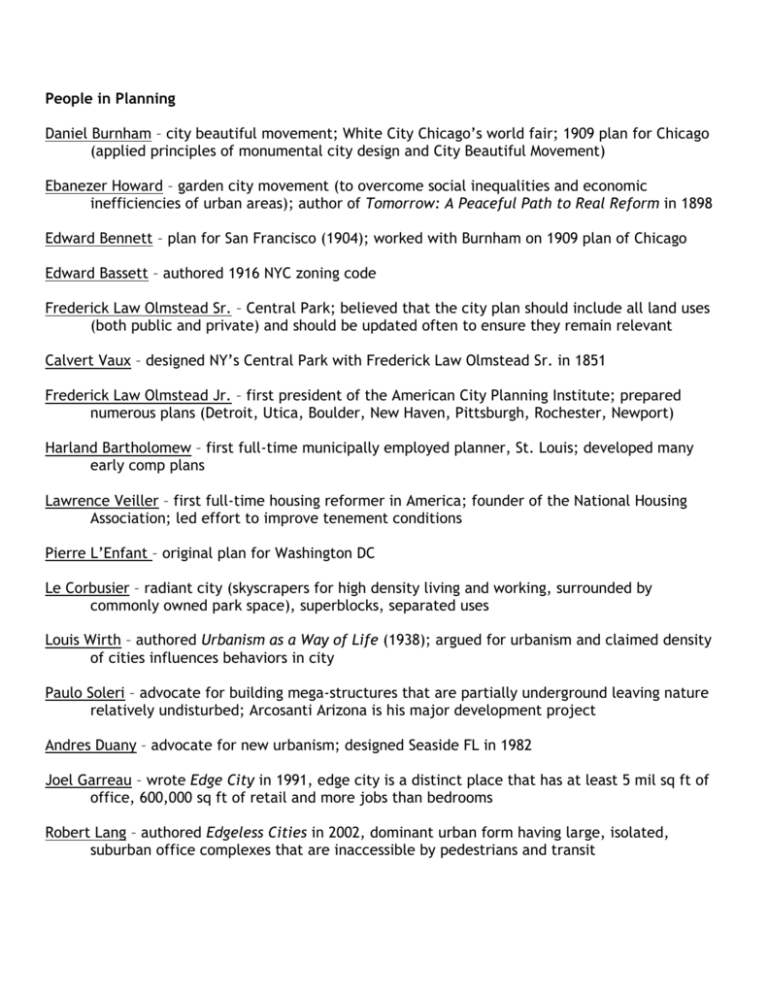
People in Planning Daniel Burnham – city beautiful movement; White City Chicago’s world fair; 1909 plan for Chicago (applied principles of monumental city design and City Beautiful Movement) Ebanezer Howard – garden city movement (to overcome social inequalities and economic inefficiencies of urban areas); author of Tomorrow: A Peaceful Path to Real Reform in 1898 Edward Bennett – plan for San Francisco (1904); worked with Burnham on 1909 plan of Chicago Edward Bassett – authored 1916 NYC zoning code Frederick Law Olmstead Sr. – Central Park; believed that the city plan should include all land uses (both public and private) and should be updated often to ensure they remain relevant Calvert Vaux – designed NY’s Central Park with Frederick Law Olmstead Sr. in 1851 Frederick Law Olmstead Jr. – first president of the American City Planning Institute; prepared numerous plans (Detroit, Utica, Boulder, New Haven, Pittsburgh, Rochester, Newport) Harland Bartholomew – first full-time municipally employed planner, St. Louis; developed many early comp plans Lawrence Veiller – first full-time housing reformer in America; founder of the National Housing Association; led effort to improve tenement conditions Pierre L’Enfant – original plan for Washington DC Le Corbusier – radiant city (skyscrapers for high density living and working, surrounded by commonly owned park space), superblocks, separated uses Louis Wirth – authored Urbanism as a Way of Life (1938); argued for urbanism and claimed density of cities influences behaviors in city Paulo Soleri – advocate for building mega-structures that are partially underground leaving nature relatively undisturbed; Arcosanti Arizona is his major development project Andres Duany – advocate for new urbanism; designed Seaside FL in 1982 Joel Garreau – wrote Edge City in 1991, edge city is a distinct place that has at least 5 mil sq ft of office, 600,000 sq ft of retail and more jobs than bedrooms Robert Lang – authored Edgeless Cities in 2002, dominant urban form having large, isolated, suburban office complexes that are inaccessible by pedestrians and transit James Oglethorpe – founder of the colony of Georgia; design for Savannah, complex gridiron with a main axis and interlinking gardens and squares Alfred Bettman – first comprehensive plan Cincinnati; filed an amicus curiae brief in support of Euclid and comprehensive zoning; 1st president of ASPO Frank Lloyd Wright – early advocator of sprawling, decongested, auto-oriented development; authored Disappearing City (1932), which presented concept of Broadacre City (each home situated on an acre or more, each house has auto) Rexford Tugwell – headed US Resettlement Administration (New Deal program) Jacob Riis – housing activist in NYC; wrote How the Other Half Lives in 1890 and Children of the Poor (social reform) Clarence Perry – neighborhood unit concept, published concept in New York City and its Environs in 1929 Amitai Etziono – founder of the communitarian movement (balance between rights and responsibilities and autonomy and order); authored the Spirit of Community Norman Krumnolz – Cleveland’s planning director (1969 – 1979); strong proponent of equity in planning Paul Davidoff – father of advocacy planning; argued planners should not be value-neutral public servant, but should represent special interest groups James Rouse – design for Colombia Maryland; pioneered development of indoor shopping malls; rejuvenated several dying downtowns by introducing festival marketplaces (Fanueil Hall Boston, Inner Harbor - Baltimore, South Street Seaport – NYC) James Howard Kunstler - wrote the Geography of Nowhere, which provides a history of suburbia and urban development; leading proponent of new urbanism; recently wrote The Long Emergency, dealing with declining oil production and the end of industrialized society Lindblom – wrote the Science of Muddling Through; incremental planning, which acknowledged that changes are made in increments Saul Alinsky – Back of Yards movement; advocacy planning; vision of planning centered on community organizing Sherry Arnstein – wrote Ladder of Participation (1969), which divided public participation and planning into 3 levels: non-participation, tokenism, and citizen power William Whyte – promoted use of environmental psychology and sociology in urban design; wrote Social Life of Small Urban Spaces in 1980; coined the term “greenway” in his book the Last Landscape; pioneer on conservation easements Allan Jacobs – authored Making City Planning Work (1985), describing what it takes to change American cities; authored Great Streets (1995), described qualities and quantities of features that characterize great streets (e.g. height of buildings, interesting facades, street trees, windows, design of intersections, street furniture, etc) Ernest Burgess – Concentric ring theory (1925) – urban areas grow in a series of concentric rings outward from CBD Homer Hoyt – Sector theory (1939) – urban areas develop in sectors along communication and transportation routes Harris and Ullman – Multiple Nuclei Theory (1945) – urban areas grow around a number of separate nuclei, which are specialized and differentiated William Alonso – Land Rent curve, bide rent theory (1960) – cost of land, intensity of development and concentration of population decline as you move away from CBD Ian McHarg – conservation design, author of Design with Nature (1969); predecessor of the overlay of layers used in modern GIS Alrede Keinus - historic preservation, wrote With Heritage so Rich in 1966 TJ Kent – author of the Urban General Plan in 1964, classic textbook on history, purpose, scope, clients and use of comp plans Rachel Carson – brought attention to the negative effects of pesticides on the environment with her book Silent Spring written in 1962 Jane Jacobs – critically looked at planners and planning, particularly the mistakes of urban renewal in her book Death and Life of Great American Cities written in 1961; advocated for mixed uses, short blocks, pedestrian-scale safety with eyes on the street Kevin Lynch – defined basic concepts within the City (paths, edges, nodes, districts); wrote the Image of the City in 1960 F Stuart Chapin – wrote Urban Land Use Planning in 1957 (common textbook on land use planning) Ladislas Segoe – wrote Local Planning Administration in 1941 (first in the Greenbook series) Nelson Lewis – wrote Planning of the Modern City in 1916 Patrick Geddess – father of regional planning; wrote Cities in Evolution in 1915 Flavel Shurtleff – wrote Carrying Out the City Plan in 1914 (1st major planning textbook) Walter Moody – wrote Wacker’s Manual of the Plan of Chicago in 1912 (used as a textbook for 8th graders) George Haussmann – 19th century plan for Paris Jonh Friedman – transactive theory Herbert Simon - concept of Satisficing (decision-making strategy attempting to meet criteria for adequacy, rather than an optimal solution) Edward Kaiser – co-authored Urban Land Use Planning; land use strategies for hazard mitigation and environmental protection; quality of local land use plans Henry Wright – designed Radburn, NJ ("town in which people could live peacefully with the automobile-or rather in spite of it") George Perkins Marsh – author of Man and Nature (1864), explored destructive impact of human action on environment and inspired conservation movement John Wesley Powell – authored Report on the Lands of the Arid Region of the United States (1878), plan that would enable settlement for the west while conserving water resources John Muir – founded Sierra Club in 1892 to promote protection and preservation of environment Gifford Pinchot – America’s 1st professionally trained forester; first director of US Forest Service (1905); leader in conservation movement John Logan and Harvey Molotch – City as a Growth Machine Theory (1987), urban development is directed by elite members of community who control resources and benefit from development Charles Mulford Robinson and George Kessler – designed Denver’s parks and parkways system in 1906 Robert Moses – influenced development of state parks and parkways in NY; helped establish the State Council of Parks in 1923 Judith Innes – consensus building and collaborative planning; author of JAPA article, Planning Through Consensus Building: A New View of the Comprehensive Planning Ideal (Autumn 1996) Peter Drucker – created MBO management technique Louis Mumford Unwin Gross national product - value of all final goods and services produced in a country in one year (gross domestic product) plus income that residents have received from abroad, minus income claimed by nonresidents Economic base analysis looks at basic and non-basic economic activities. Basic activities are those that can be exported, such as automotive manufacturing.

